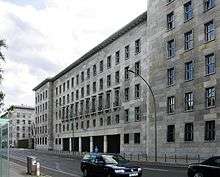Ernst Sagebiel
Ernst Sagebiel (2 October 1892 in Braunschweig (Brunswick) – 5 March 1970 in Bavaria) was a German architect.
Life


Sagebiel was a sculptor's son, and after his Abitur in 1912, he began his studies in architecture at the Braunschweig University of Technology. He eventually finished his studies in 1922, after they were interrupted by his participation in the First World War, which included a stay in a prisoner-of-war camp. In 1924, he joined Jakob Körfer's architectural bureau in Cologne. In 1926 came his doctorate ("Promotion"). In 1929, Sagebiel took up a job in Berlin as a project leader and chief executive officer at the architect Erich Mendelsohn's office, but in 1932, he had to leave this job owing to the severe economic climate in Germany at that time. He worked as a construction foreman.
After Adolf Hitler and the Nazis seized power in 1933, Sagebiel applied for membership in the NSDAP, and became a member of the Sturmabteilung (SA).
Already by 1933, Sagebiel had, at his brother's suggestion, come to be at the Deutsche Verkehrsfliegerschule ("German Commercial Flyers' School"), which was a front organization involved more with Germany's air force buildup than with commercial flying. As of 1934, he was being trusted with planning, as well as overseeing construction of, numerous Luftwaffe barracks (in Döberitz, Berlin-Gatow and Kladow, to name a few) as leader of the special works unit.
In 1934 and 1935, he gave Germany its first major building project in the time of the Third Reich – the new Reich Air Transport Ministry. Later, he found himself busy with another project, Tempelhof Airport, then the world's biggest building.
Sagebiel's building style, which when compared to Albert Speer's rather classicist tendencies came across as very stark and linear, was described as "Luftwaffe modern", owing not least to his close association with the Luftwaffe. With his earlier building of the Reich Air Transport Ministry for Hermann Göring, which came earlier than Albert Speer's exertion of influence on the National Socialists' architectural parlance, Sagebiel set a trend that would be recognizable throughout the Third Reich. From 1938, he was directly subordinate to the Air Transport Minister, Hermann Göring, and was thereby counted among the Reich's most important architects. In the same year, he became a professor at the Technische Hochschule Berlin.
With the outbreak of war against the Soviet Union in 1941 came an end to all Sagebiel's building plans.
List of projects and plans
- Columbushaus, Berlin, Project management for Erich Mendelsohn
- Reichsluftfahrtministerium, Berlin 1934 – 1935
- Tempelhof International Airport, Berlin 1935 – 1941
- Stuttgart Airport
- Munich Riem Airport
- Bücker Aircraft Works, Rangsdorf
- Regional Air Command Centres in Kiel, Königsberg and Münster
- Luftwaffe schools in Berlin-Gatow, Dresden and Potsdam-Wildpark
Literature
- Elke Dittrich: Ernst Sagebiel - Leben und Werk (1892 - 1970). Lukas Verlag Berlin 2005, ISBN 3-936872-39-2
- Laurenz Demps und Carl-Ludwig Paeschke: Flughafen Tempelhof. Ullstein Verlag, 1998, ISBN 3-550-06973-1
- Hans J. Reichhardt, Wolfgang Schäche: Von Berlin nach Germania. Transit Buchverlag, Berlin 2005 (gebundene Ausgabe), ISBN 3-88747-127-X
- Wolfgang Schäche: Architektur und Städtebau in Berlin zwischen 1933 und 1945. Gebr. Mann, Berlin 2002, ISBN 3-7861-1178-2
- Jost Schäfer: Das ehem. Luftkreiskommando IV in Münster von Ernst Sagebiel, in: Zeitschrift Westfalen, 76. Bd. Münster 1999, S. 380-401. ISSN 0043-4337
See also
External links
| Wikimedia Commons has media related to Ernst Sagebiel. |
- Ernst Sagebiel in the German National Library catalogue
- Ernst Sagebiel at the archINFORM database.
- Biography at the German Historical Museum (in German)
- Tempelhof Airport's website (in German)